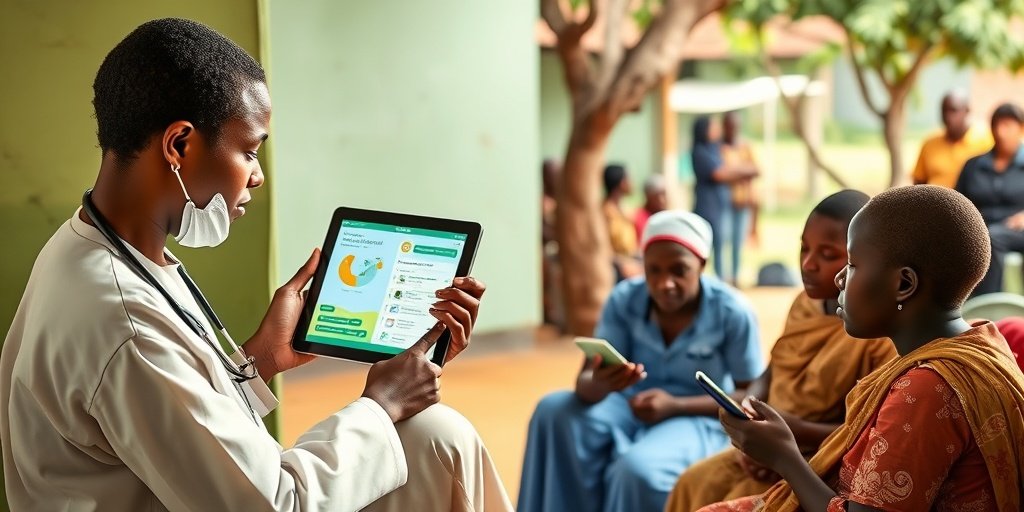⚡ Quick Summary
This systematic review highlights the evolution of digital health interventions over the past 25 years in low- and middle-income countries, showcasing their significant role in enhancing health care accessibility and equity. The findings emphasize the transformative impact of technologies like mobile health apps and the acceleration of digital health adoption during the COVID-19 pandemic.
🔍 Key Details
- 📅 Timeframe: 25 years of digital health evolution
- 🌍 Focus: Low- and middle-income countries
- 📱 Initial Interventions: SMS platforms targeting specific health issues
- 🚀 Advanced Technologies: Mobile health apps, AI, machine learning, blockchain
- 📈 Impact of COVID-19: Accelerated adoption of digital health solutions
🔑 Key Takeaways
- 📊 Digital health interventions have evolved from basic SMS to comprehensive mobile health applications.
- 💡 These tools have improved access to health care for remote and marginalized communities.
- 🏥 The COVID-19 pandemic significantly boosted the use of digital health for information dissemination and virtual consultations.
- 🤖 Emerging technologies like AI and blockchain hold promise for future advancements in digital health.
- ⚖️ Challenges remain in ensuring equitable access and addressing disparities in digital literacy.
- 🤝 Collaboration among stakeholders is crucial for maximizing the potential of digital health.

📚 Background
Over the last quarter-century, the landscape of health care has been transformed by the integration of digital health technologies. In low- and middle-income countries, these innovations have been pivotal in addressing health care disparities, particularly in regions where traditional health care access is limited. The increasing availability of the internet and mobile devices has further catalyzed this transformation, allowing for a more connected and informed patient population.
🗒️ Study
This systematic review conducted a retrospective analysis of digital health initiatives over the past 25 years, focusing on their evolution from simple text messaging platforms to sophisticated mobile health applications. The study examined various literature and case studies to identify key milestones, successes, challenges, and opportunities in the realm of digital health in low- and middle-income countries.
📈 Results
The findings revealed that initial digital health initiatives effectively targeted specific health issues, such as malaria, using text-based platforms. As mobile phone ownership and internet access expanded, these interventions evolved into comprehensive mobile health applications that support self-care, patient education, chronic disease management, and remote consultations. The COVID-19 pandemic acted as a catalyst, significantly increasing the adoption of digital health solutions across various health care systems.
🌍 Impact and Implications
The implications of this study are profound. The evolution of digital health interventions has the potential to revolutionize health care delivery in low- and middle-income countries. By leveraging emerging technologies, we can enhance health care accessibility and equity, ultimately leading to improved health outcomes. However, it is essential to address the existing challenges, such as disparities in digital literacy and infrastructure, to ensure that these advancements benefit all segments of the population.
🔮 Conclusion
The future of digital health interventions in low- and middle-income countries is bright, with the promise of emerging technologies paving the way for innovative solutions. As we continue to navigate the complexities of health care delivery, collaboration among governments, health care providers, and technology innovators will be vital in overcoming challenges and harnessing the full potential of digital health to improve health care outcomes. The journey is just beginning, and the possibilities are endless!
💬 Your comments
What are your thoughts on the evolution of digital health in low- and middle-income countries? How do you see technology shaping the future of health care? 💬 Share your insights in the comments below or connect with us on social media:
25 Years of Digital Health Toward Universal Health Coverage in Low- and Middle-Income Countries: Rapid Systematic Review.
Abstract
BACKGROUND: Over the last 25 years, digital health interventions in low- and middle-income countries have undergone substantial transformations propelled by technological advancements, increased internet accessibility, and a deeper appreciation of the benefits of digital tools in enhancing health care availability.
OBJECTIVE: This study aims to examine the evolution, impact, and prospects of digital health interventions in low- and middle-income countries, highlighting their role in improving health care accessibility and equity.
METHODS: A retrospective analysis of digital health initiatives scanning the past two and a half decades focused on the progression from basic SMS platforms to sophisticated mobile health apps and other health digital interventions. Relevant literature and case studies were reviewed to elucidate key milestones, successes, challenges, and opportunities in advancing digital health initiatives in low- and middle-income regions.
RESULTS: Digital health initiatives in low- and middle-income countries initially targeted specific health concerns, such as malaria diagnosis and treatment, through text-based platforms, demonstrating their efficacy in reaching remote and marginalized communities. With the proliferation of mobile phone ownership and internet access, these interventions evolved into comprehensive mobile health apps, facilitating self-care support, patient education, chronic disease monitoring, and remote consultations. The COVID-19 pandemic further accelerated the adoption of digital health interventions, particularly in disseminating health information, supporting contact tracing efforts, and enabling virtual consultations to alleviate strain on health care systems.
CONCLUSIONS: The future of digital health interventions in low- and middle-income countries holds immense promise, fueled by emerging technologies such as artificial intelligence, machine learning, and blockchain. However, challenges persist in ensuring equitable access to digital health technologies, addressing disparities in digital literacy, and establishing robust health care infrastructure. Collaboration among governments, health care providers, technology innovators, and communities is essential to overcome these challenges and harness the full potential of digital health to improve health care outcomes in low- and middle-income countries.
Author: [‘Sylla B’, ‘Ismaila O’, ‘Diallo G’]
Journal: J Med Internet Res
Citation: Sylla B, et al. 25 Years of Digital Health Toward Universal Health Coverage in Low- and Middle-Income Countries: Rapid Systematic Review. 25 Years of Digital Health Toward Universal Health Coverage in Low- and Middle-Income Countries: Rapid Systematic Review. 2025; 27:e59042. doi: 10.2196/59042